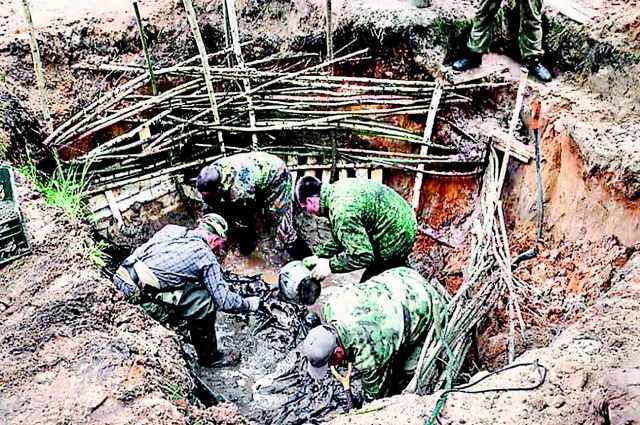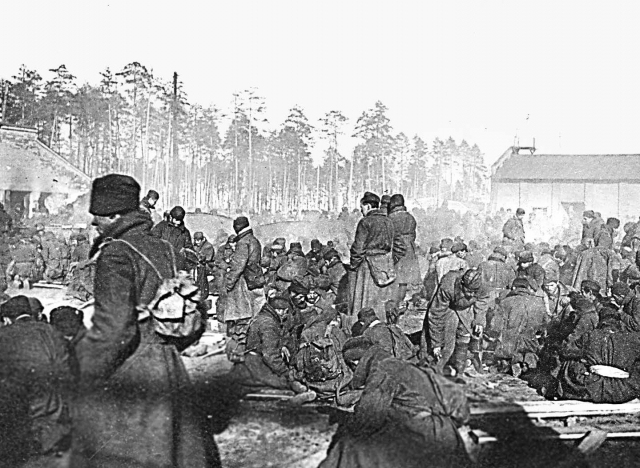Weekly “Arguments and facts” 28. The ninth wave of bad weather. Why is there a flood in southern Russia? 07/14/2021

A & nbsp; Bryansk opened the cemetery of the former German POW camp. They opened and & nbsp; were horrified.
In Nazi Germany there were 14 thousand. camps of various profiles: death camps, camps for soldiers and & nbsp; for officers … but & nbsp; The most numerous were transit camps & nbsp; & mdash; DOULAGI.
Don't trust the 'harmless' name: in & nbsp; dulags (short for & nbsp; German word Durchgangslager & nbsp; & mdash; transit camp for prisoners of war) no fewer people died than in & nbsp; death camps. In & nbsp; a 'Dulage-142' to & nbsp; in Bryansk, the Nazis killed 40 & nbsp; thousand. people.
Briansk Buchenwald
On May 30, excavations began on the site of the old camp. According to & nbsp; available at & nbsp; at that time, during & nbsp; 2 & nbsp; years until 'Dulag-142' passed to & nbsp; 80 & nbsp; thousand. Soviet citizens, half of them died. Judging by how deep the remains lie, search engines realized people weren't really buried. The corpses are in & nbsp; several layers. At first we met in & nbsp; mainly the remains of the civilian population, but & nbsp; somewhere nearby there is also & nbsp; graves of prisoners of war. The territory on which the mass graves are located, & nbsp; & mdash; 53 & nbsp; hectares.
In addition to the volunteer search engines, the Committee of Inquiry is involved in the painful work. “ The central office of the Russian Investigative Committee is investigating the criminal case on the & nbsp; genocide of the peoples of the USSR, & nbsp; & mdash; declares the representative of Bryansk SU & nbsp; TFR Alexander Afonin. & mdash; & nbsp; In the beginning, we were working in the archives of & nbsp ;. Investigators, as well as search engines, conduct examinations of burial sites, remove the remains, examine them, appoint the necessary forensic examinations. & # 39; & # 39; and & nbsp; detachment of the 615th Ukrainian Punitive Battalion, which was part of the Desna Collaborationist Volunteer Regiment. & nbsp;

Durchgangslager & ndash; transit camp for prisoners of war n ° 142, November 1941 & nbsp; Photo from the collection of Pavel Marchenkov. archive-bryansk.ru, bryanskobl.ru
With & nbsp; special cruelty
The current investigation is not the first in the history of Dulag-142. After the liberation of the Bryansk region, state commissions were established in all regions to study the atrocities of the occupiers. The figure in & nbsp; 40 & nbsp; thousand. the dead were already named then. Since the 40s. Known and & nbsp; the testimony of a 3rd rank military medic Dmitry Miminoshvili, which was captured in & nbsp; October 1941 & nbsp; g. He testified before the commission about the & nbsp; daily death in the & nbsp; 200 camp & ndash; 250 & nbsp; people. Among the most common diseases, the military doctor named the edematous disease of hunger, tuberculosis and typhus. In the testimony published by archivists from the Bryansk region, Miminoshvili described the concentration camp as follows: there was a double wire fence around, and the territory itself was enclosed by many wire fences. barbed wire. The Germans fed the prisoners rotten meat and & nbsp; unrefined buckwheat, as a result of which the prisoners became overwhelmingly ill with rectal gangrene. The corpses, loaded onto the sled, were taken by prisoners of war to the cemetery. In addition to the fact that people were starving, they were & nbsp; beaten and & nbsp; slaughtered. Major Weise & nbsp; & mdash; Commander Dulag & nbsp; & mdash; personally shot 200 prisoners and & nbsp; beaten as many & nbsp; to & nbsp; dead.
Miminoshvili worked in the camp infirmary, which was commanded by a German military medic by & nbsp; last name Dyullman … he was remembered for beating Russian colleagues on a regular basis, forcing them to march through the frost and stand to attention on time, resulting in cases of frostbite and frostbite death. Among the officers, besides Major Weise, Captain Geber , Captain Cinicker , NCO Bauer , Corporals Hetchel and & nbsp; Wulper . And & nbsp; after all, somewhere in & nbsp; Germany, maybe their & nbsp; grandchildren and & nbsp; great-grandchildren live, knowing nothing about & nbsp; these “ exploits. & # 39; & # 39; & Nbsp;
Horror in the & nbsp; barracks
Peasant Alexander Sakhnenko the Germans 'evacuated' to & nbsp; Dulag, when they cleared the area of & nbsp; possible accomplices of the partisans. She described the camp kitchen menu as follows: morning tea and & nbsp; 200 & nbsp; g of bread for adults and & nbsp; 100 & nbsp; g for children, in & nbsp; 5 & nbsp; hours & nbsp; & mdash; liter of gourd of & nbsp; whole buckwheat flour for & nbsp; an adult and & nbsp; half a liter for & nbsp; child. In the words of & nbsp; Sakhnenko, when there were only prisoners of war in the & nbsp; camp, the food was even worse: they gave uncooked buckwheat or half-raw vegetable scraps, and & nbsp; sometimes and & nbsp; did not & nbsp; give anything.
testimony of the municipal commission for & nbsp; establish the damage caused by the occupants to the city of Bryansk, she spoke of & nbsp; life in the & nbsp; camp. On the territory of the base there were more than 10 barracks. In & nbsp; each of these & nbsp; Germans and & nbsp; police officers have packed 1200 & mdash; 1500 & nbsp; people. The prisoners slept on wooden planks on floors 4, which were swarming with insects. After the war, the parasites had to be burnt with sulfur.
For & nbsp; the slightest offense followed by punishment. For example, if a & nbsp; fire, people were beaten with whips and & nbsp; deprived of food. Sakhnenko described a case where a woman was beaten in & nbsp; to death for & nbsp; the fact that its & nbsp; child fell into the & nbsp; bathroom. & Nbsp;
& # 39; Hands were sticking out of the & nbsp; earth '
Until & nbsp; 2019 & nbsp; g. & Nbsp; on & nbsp; the territory of the former camp operated the 85th factory, which repaired tractors for missile systems. Previously (the company had been in existence since & nbsp; 1924 & nbsp; g.) Tanks and & nbsp; other military equipment was being repaired there. The General Staff knew that the country's defense was forged on the bones of dead prisoners.
The first post-war plant manager Pyotr Suzik recalled: “ On the territory of the camp there was a cemetery surrounded by a birch fence and birch crosses on the graves. At the entrance of the & nbsp; cemetery there was a portal with a & nbsp; registration & bdquo; Peace be upon you & ldquo ;. During the excavations of the camp, it was discovered that in each grave there was & nbsp; 24 & nbsp; people. The corpses were stripped and & nbsp; placed face down. Most of the skulls were pierced and broken. Many corpses were buried there. Hands and feet protruded from the ground. It was decided to redecorate the cemetery. & # 39; & # 39; & Nbsp;
No prescription
The dulags existed in & nbsp; all occupied territories of the USSR: in & nbsp; Ukraine, & nbsp; Belarus, & nbsp; Baltic. Most were closed within months, as soon as prisoners stopped arriving from the front lines. Others have worked for years: Dulag-134 in & nbsp; Lgov, Kursk region. & mdash; & nbsp; more than 2 & nbsp; years, & laquo; Dulag-124 & raquo; in Gzhatsk (now Gagarin) & nbsp; & mdash; of & nbsp; October 1942 to & nbsp; August 1944. Here are the memories of a prisoner from this particular camp: “ Behind & nbsp; rusty rows of barbed wire and & nbsp; on & nbsp; towers & mdash; German sentries, and & nbsp; inside & nbsp; & mdash; policemen in & nbsp; overcoats of good commanders and & nbsp; Black Kubanks. In & nbsp; their bestial cruelty, they weren't & nbsp; just not & nbsp; inferior to the owners, but & nbsp; sometimes even & nbsp; surpassed & nbsp; their & nbsp ;.
Dulag-100 to & nbsp; Porkhov near Pskov worked until & nbsp; 1944 & nbsp; g. In & nbsp;, it simultaneously housed up to & nbsp; 30 & nbsp; thousand. people who died every day of & nbsp; 100 to & nbsp; 150. The bodies were thrown into the ditches, not covered with earth. After the war, the commission numbered 85 & nbsp; thousand. remains. In & nbsp; 2016 & nbsp; city & nbsp; at l & nbsp; place of the camp of & nbsp; in memory of & nbsp; his victims, a memorial complex was opened.
In total, in the & nbsp; war on & nbsp; the occupied territory of the RSFSR, there were 40 & nbsp; dulags And & nbsp; what do we know & nbsp; about & nbsp; ? Is it fair & nbsp; the fact that the commanders of & nbsp; were hardly & nbsp; were more human, the guards are kinder and & nbsp; the food is more satisfying than in & nbsp; the Bryansk camp at number 142./p>
The Lord's millstones creak slowly, but & nbsp; tirelessly. So & nbsp; in & nbsp; our country for & nbsp; the crimes of the Nazis have again undertaken in & nbsp ;. According to & nbsp; from the official representative of IC & nbsp; RF & nbsp; Svetlana Petrenko, “ working for & nbsp; establish all the circumstances of the crime and & nbsp; the people involved in & nbsp; its commission, will continue, since such crimes do not & nbsp; statute of limitations & nbsp; ;.
The material used extracts & nbsp; publications of the State Archives of the Bryansk region.

